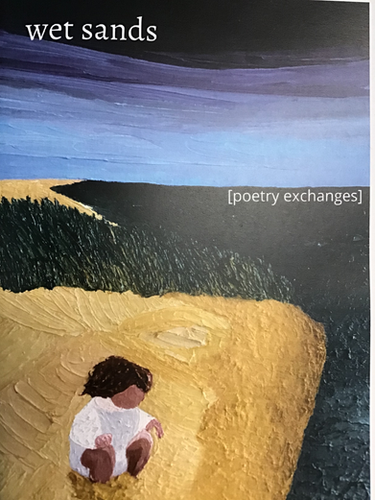*
“A small disunified theory” constellates from a lyrical response to Leslie Jamison’s “Grand Unified Theory of Female Pain” to a further diagnosis of late-stage capital’s easy co-opting of raw moment’s bodily musk spill, our meat’s revolutionary intensities suddenly dimmed by the weight of brands, these “names.” Or, as restrepo rhodes states:
The fetish of radiant tragedies, handmaidens
dressed in collateral adjectives1.
But not only words, not only adjectives, bodies are rendered “a menagerie.” Particular kinds of bodies. “A menagerie” rendered by “the doctor’s / script, his terrible cursive. Patriarchy’s bloat / & interlock. Exploit & cramp.”
*
Leslie Jamison’s nonfiction essay is written with language as vivid as the cherry reds in the image of Cecily Brown’s “The Girl Who Had Everything,” the oil painting digitally accompanying the published essay. In the image, runny red and whites sometimes taffy-smear together, while other arching gestures wipe back and forth in blood spills or rainbows in red shades; in the smears, there, edging toward cohesion but ever dispelled just as it might appear to cohere: faces, hands, the upraised curve of exposed legs, groin, there for one moment when hue is understood as spatial dimension, then gone again, and just those swirls like candy cane melted, spattered, and angel-wiped on snow.
Brown’s painting captures in oil the nonnormative order, a “disunified” order, that Leslie Jamison’s essay performs in prose. A swirl in form and style, Jamison’s lyrical, honest, and wide-ranging essay speaks to the very complexity, the paradoxes and contradictions, the conflicted economies, that arise in depicting female loss:
that wounds are desired and despised; that they grant power and come at a price; that suffering yields virtue and selfishness; that victimhood is a mix of situation and agency; that pain is the object of representation and also its product; that culture transcribes genuine suffering while naturalizing its symptoms2.
In Jamison, the wounds are both real and, once depicted, are framed in ways that complicate and demand the reframing of one’s individual confluence of intersectional identities.
*
heidi andrea restrepo rhodes’s “A small disunified theory” kalidescopes the radiance suffusing the ideas found in Jamison’s essay. However, rhodes’s lyric posits critical side paths and folds to follow, other whens to make one’s tomorrow, when speaking of one’s wounds, and/or of one’s identities, one’s subjects.
*
In Vital Signs, heidi andrea restrepo rhodes and Tala Khanmalek state, “As chronically sick, and disabled queer artists of color, we draw on legacies of crip thought.” Participating in the same discourses as disability studies and disability rights, a crip thought, as Robert McRuer writes in “Crip World-Making,” “is also always particularly interested in that which is in excess of an able-bodied/disabled binary3.” Crip blurs solid whites and reds in taffy swirls, interested in other logics and knowledges beyond archaic rationalities of embodiment, two dimensions blinking into three and/or more.
Whether as a term, an identity, a methodology, or a sensibility, crip’s intersecting interests and energies evade easy “definition.” And this is beautifully purposeful. For as the editors of Crip Genealogies articulate, “Aboutness enables a distinctly arboreal genealogy in that it cuts off transversal affinites and rejects rather than welcomes uncommon archives, unexpected coalitions, tangential conversations, and mixed methods. It rejects muted, but crucial, presences4.”
As in Cecily Brown’s painting, where shapes ever coalese in and out of coherency, in and out of the swirls, blinking as the swirls, crip thought welcomes unexpected coalitions and transversal affinities. Whether as a term, an identity, methodology, or sensibility, crip thought or crip theory encompasses a diverse range of perspectives and approaches within and outside of disability studies.
One crip approach might explore the intersections between disability and non-normative gender and sexuality, while another might argue that disability is primarily a product of societal failure to accommodate and include people with impairments, while yet another might emphasize the agency and voices of individuals with psychiatric disabilities.
Crip thought activates many questions; one from Crip Genealogies radiates: “How does a mandate for coherence in disability studies serve whiteness, white supremacy, and forms of cultural or intellectual imperialism5.” Elsewhere in their introduction exploring a geneaology of the word “crip,” the editors of Crip Genealogies address how:
[t]he possiblities, effects, costs, and implications of living with disabilities are deeply entangled with ongoing histories of racism, classism, disenfranchisement, violence, and geopolitics, suggesting that the link between Crips [the gang/underground economic organization] and crip is no mere coincidence6.
Crip is of many energies, whether in academia, or within disability-centered communities, whether as a noun or as a verb, cripping.
*
The poem “A small disunified theory” crips. heidi andrea restrepo rhodes crips when describing her hopes of her own poetics:
counterhistory, documentation, evidence of the entanglements of the systems plaguing us; offer otherwise pathways to selfhood, desire, erotics; grieve and celebrate; to push, as Aimé Césaire writes, ‘against the indistinct grey of the world,’ which is to say, against fascism and all its supremacies, which is to say against the death of poetry, the death of we monsters who will never be deemed saints. I want it to be for the wonder and joy and otherwise of abolition, of queer’s ever-winding and wending ways, of sensual excess and brown jouissance (Amber Jamilla Musser’s words), of the crip marvelous, of the sacred in the profane, of holding to life and holding to love in our bones. I want it to be an ecology of possibilities and strangenesses that reject estrangement as the requisite on which liberal humanity is contingent, and invite us to lattice ourselves in its excesses and outerspaces7.
*
My aesthetic harmonizes with holding when rhodes writes in “A small disunified theory,” “Our wounds, our bodies & their becomings,” as “[a] fetal universe in lambent hungers.” For there, the body: of and in the intimate of our individual flesh, “the names of your mothers, you mine.” There in each other’s flesh that differs, in our pains, in our shared nerves and organs, in our wounds, we find in our shared heritages the open space of “fetal” light, a new kind of lineage.
*
Intersectional and cross-dimensional, to crip positions my writing-body’s privilege openly. This nonfictional “I” is not female. It has never felt female pain. “I” present as masculine, male. My confluence of identities include signifiers like, Chicano. Latinx. Neurodiverse. A child of Agent Orange.
…. my cerebellum sewn with hair and bleeding with tulips. My mind rambles sound and sound and sound and sound—Quiet: hangs from fingers beaded together and tapping. My mind is loosening. How can I enter that round, light flashing inward toward a means of escape I find myself avoiding.
…. my sewn cerebellum a rosebud of flesh pulsating dark. From it exhalations of spotted blood. Where death feels the stems of memories. Breaking them. Milky blood. A white paste thickening consciousness. Embryos of loosening.
*
heidi andrea restrepo rhodes writes, “we know how to handle each other’s / blood. How to butter our bread.”
For this is the kind of testimony, initimate and viscious, that is bodily knowledge in exchange: those difficult moments of transparency, the raw relief of acceptance, the other incorporating us, us incorporated and incorporating, buttering “our bread” with our shared intimacies.
And we are held. Crip’ly (un)Known.
And, then (perhaps better to write, there), we become each other’s adjective, “I your / & you mine, I your & you mine.” “I your,” the possessive adjective acting more as a verb in these lines of the poem. “Your” is active, activating, nearly a strategy the “I” does. And vice versa: you are “youring” me just as you “I.”
Could this be the dimensional reframing restrepo rhodes implies when she writes, “Drastic shapes / call for what will be deemed drastic measures.” Are we, when/where self-aware of each other, what restrepo rhodes calls, “the outside, orchestral noise”? When a “drastic shape” must call upon an equally drastic action, shape calls on organized noise, something almost shapeless, something outside the known parameters of a form, something that can only be called noise, an “orchestral” incoherence sounding, pushing measurement into unheard of fields of conception.
*
Is that one way to truly hear restrepo rhodes, and “summon the memory, the nebulous / conditions of our devastation”?
To exa/mine myself as I mine how the waxcomb geometry is less of purpose than of fundamental elemental secretion, the wax the bee transmutes from the remains of the nectar it had gathered from the passion flowers just this morning spreading out to expose ovaries soft as grass wax steepled by a fleshy three-pronged stigma, all haloed by a purple, white contra black punk mohawk coronal filament orbiting the nectary?
How does my momentary “I” summon and altar the cry,
the call to speak restrepo rhodes’ “The throb / & burn of aperature & rift”?
How do I do this in form to represent the endless and beautiful non-,
where “from the outside, orchestral noise abounds”?
*
Together, bound by our bodies and being with each other as bodies, there might be something better than “the fibrous needs of the heavens.” Perhaps, out here, in beetle mouth, amoeba, in the sugar water suckle of a hummingbird. A bruised blue so beautiful, and dusted.
heidi andrea restrepo rhodes guides us here; for, in here, resting in our interpenetrating bodies, “[a] snow early & long in the arms.” And there, “we are, coruscating against invasion.”
*
For heidi andrea restrepo rhodes, we, all of us, are a shared hunger. Crossing all our walks where no step has set. A ceaseless guiding. As our beloved flesh fraughtness.
For, as restrepo rhodes writes, “How improbable we are.”
Notes
1 heidi andrea restrepo rhodes. “A small disunified theory.”
2 Jamison, Leslie. “Grand Unified Theory of Female Pain,” Virginia Quarterly Review, Spring 2014. Accessed 9/2023; <https://www.vqronline.org/essays-articles/2014/04/grand-unified-theory-female-pain>.
3 McRuer, Robert. “Crip World-Making” in Crip Authorship: Disability as Method. Ed. Mara Mills and Rebecca Sanchez. New York University Press; NYC. Pp 274-281.
4 Mel Y. Chen, Alison Kafer, Eunjung Kim, Julie Avril Minich, “Introduction: Crip Genealogies” in Crip Genealogies, Editors Mel Y. Chen, Alison Kafer, Eunjung Kim, Julie Avril Minich. Duke University Press; Durham, North Carolina, 2023. Pp 8.
5 ibid, Pp. 28.
6 ibid, P.8.
7 from a personal email, quoted with permission from heidi andrea restrepo rhodes




